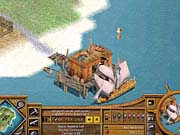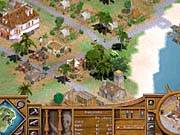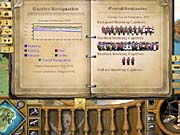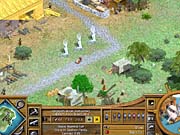Tropico 2 Hands-On Preview
Yar! Here's your chance to pick up a cutlass and be king of the pirates.
Pirates have feelings too. And in Tropico 2: Pirate Cove you'll hear all about them as you run an island haven for sailors enjoying a little R&R from their difficult day job: preying on lucrative Caribbean trade routes. Tropico 2 has borrowed a little more than the engine and tropical setting from PopTop's acclaimed 2001 strategy game, but the management premise has been turned on its head. The feisty pirates bring back booty from their voyages, and it's up to you to manage a captive workforce with the goal of keeping the pirates well-equipped and happy. If you ever wondered what pirates might do in their off-time, then here's your chance to find out.

The easiest way to learn Tropico 2 is to play the single-player campaign, which at first consists of quick tutorial missions that teach the basic elements of the game. There's a loose story presented in the text briefing for each mission: You're a convicted gambler sent to the colonies who's escaped on a ship with Charlotte De Berry, and the two of you divided things up so she captains the ship and you're in charge of building a hideout. The first mission introduces you to the basic elements of an island economy: timber camps and a sawmill for wood, the main building resource, and corn farms and a sea biscuit factory to create food stores for the ships and to keep the local captives feasting on slop. But soon Charlotte will return, and you'll not only have some basic control over the ship, but will have to keep the sailors happy when they're on shore.
Since you're not running a legitimate colony, you don't have the option of making money by time-consuming, ordinary methods. Simply send a well-equipped ship out to cruise the seas, and with some luck it'll come back with gold, pirate recruits, and captives. But equipping a ship is a challenge in itself. The campaign will soon introduce you to weapon-making, which will require you to set up an iron mine, a smelter, and then one of three shops to produce cutlasses, muskets, or cannons. The trick is that you'll need enough captives to keep these labor-intensive operations running, and if you don't have the weapons to go hijacking ships on the open seas, then you'll either have to hope for captives to wash up on shore from sea wrecks (this happens pretty often at the start) or explore the map with your defenseless ship to find an unguarded trading settlement to raid.

But even once you have the means to arm your pirates, you might not find much success if your pirates are unhappy. Apparently, pirates get into a funk if they can't get enough drinking, gambling, and companionship while on the island, and they'll turn into cowards when it comes time to do their jobs. The audible cries for more pirate services and the possibility of pirate revolt should keep you plenty motivated to build and staff a chaotic pirate paradise. The basics are fairly cheap and easy to build, but it'll cost you if you want the fancy inns, taverns, and casinos that cater to high-ranking pirates. You can't pick just any sorry captive off the street and expect him to run such establishments, so it'll take a special ship mission to go out and specifically find skilled captives that already have the know-how. Such missions are relatively routine and cost just 250 gold, but they do keep your pirates from the more lucrative cruises.
A Pirate's Life for Me

Nearly right off the bat, there will be a second pirate captain on the island, and you'll need to build a second ship to keep him busy and keep the gold flowing into the coffers. There's a range of progressively more powerful ships to build, but the sloop is a good place to start, since it's the best light ship available. At this point, you should actually begin to see some real sea action, because the better your ship, the less often the pirates will run away out of fear of being sunk by enemy cannons. In fact, there's always some risk that a ship will be taken and a captain captured, which can sink your economy in a hurry. One way to lower the risk is to check the strategic map to see which regions are being patrolled by English, French, and Spanish warships, but more important is being able to switch between tactics: boarding ships with cutlasses is the riskiest but has the greatest reward, while relying on muskets or cannons decreases the risk. One consideration is the skill levels of your pirates, which are recorded in exacting detail, like most every other bit of demographic data you could possibly be interested in. But given how important the ship cruises are to the game, it's a little disappointing that the battle results aren't presented in a more engaging way. There's a pop-up window that details the loot gathered on a cruise, but individual battles are relegated to a text log.
The real focus of the game is balancing the need to build a variety of services for the pirates with other building projects to keep the captives in line. Those familiar with Tropico won't be surprised that each individual on the island is kept close track of, and you can either click on random individuals walking around to get an impromptu survey or use the log book to see the island's population divided up in a variety of useful ways. But one major departure from the earlier game is the emphasis on added themed "décor" elements to increase the ratings that help pirates (anarchy and defense) and the ratings that keep captives in line (order and fear). While certain buildings radiate these influences in appropriate ways, to fill in the gaps you'll drop décor items like giant skeletal hands. While it does make for interesting gameplay, ungainly lines of these fear-increasing items do look rather odd, even given the generally comical visual style of the game.
Flourishing pirate towns do come to look rather prosperous--the major service buildings are quite large, and the income pirates keep from their deeds has a positive effect on how their private homes appear. There's also the opportunity to set up a private stash of your own, which carries over from one campaign mission to the next. Tropico 2's graphics generally have the same look as those of its predecessor--the sun-drenched beaches are made of 3D terrain and buildings have a 2D look that is quite detailed when you zoom right in--and the engine hasn't seen any notable technical improvements since 2001.

Tropico 2 still has the sandbox mode that was the first game's primary mode of play, but for extra variety and replay value there are a number of scenarios in addition to the campaign. The nearly final version of the game we had a chance to try out included nine scenarios of various difficulty levels, and there's an included map editor you can use to edit existing scenarios or create your own. The sandbox mode has a create-a-pirate feature that lets you determine the pirate king's background in some detail, which has a distinct impact on how expensive items are, how the three major nations are disposed to you, and how difficult it will be to keep your captives and pirates in line. Tropico 2 is an entertaining take on pirate life, and it packs in a number of tweaks to the original game's gameplay formula to keep things interesting. You can look for Tropico 2 in early April.
Got a news tip or want to contact us directly? Email news@gamespot.com
Join the conversation